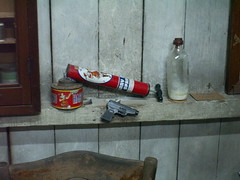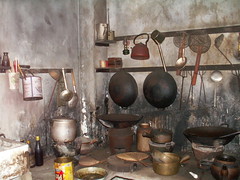
In Cantonese we called it ‘woon kwai’ (碗柜). It is used for storing cups, bowls and other eating utensils. Can you see the bowls? The see-through ‘window’ is in fact made of wire mesh. The purpose was to keep out insects. This is because this cabinet was also used to store food leftovers. I am talking about the 1950’s when we did not have electricity supply to our kampong yet and thus we had no refrigerators.
Do you notice that the legs of this cabinet are resting on 2 bowls? Do you know why this is so? (Hint: We usually fill the bowls with water)

The purpose, as you have probably guessed, was to create a ‘moat’ so that ants cannot crawl up the cabinet to reach our food. Of course, this led to mosquito breeding. What we usually do, when we remember that is, was to scoop up the mosquito larvae to feed our fighting fish. (See my previous post).
Anyway, mosquitoes were rampant and we would use this type of insecticide sprayer to spray Shelltox to kill them. I am curious as to whether my young readers have seen this before. Do you know how it functions? I remember studying about it in our physics lesson once. In Cantonese we called it ‘mun yau (蚊油) pump’.

When electricity finally came to our village, one of the first electrical appliances that we bought was a refrigerator. I think the brand was Kelvinator. Have you heard of this brand before? It was very popular before the invasion of the Japanese brands. As usual, it was our more technically advanced cousins, the Ngs, who recommended us this brand. Remember the Minolta camera that I blogged about earlier? Well, that was also recommended by them.
Maybe I should explain one more thing for the benefit of my young readers. Do you see the pot and kettle in this photo. Do you know what we do when these items are broken or worn out? Nowadays, we would throw them away of course. But back in the kampong days, we would get a tinker to repair (please don’t say you do not know what is a tinker). As kids we liked to watch the guy use a solder iron to repair the holes and cracks in the pots and kettle. This is another one of those extinct trades that the present generation probably have not seen before. Speak of solder, and they will probably think of printed circuit boards. Am I right?

I hope you have gained a better understanding of life in the 1950’s after reading this post. More next time.





11 comments:
Hi Mr Lam
My family had one of those woon kwai, through the 70s and part of the 80s. Complete with the water bowls for the legs! My mother called it the 'meat safe'.
Yes. I recalled my family had one woon kwai too. But I don't remember my mom ever placed little bowls on the legs. And that insecticide sprayer... I've almost forgotten about its existence! Thanks for the memory, Chun See.
Back in the fifties people were very frugal because jobs were not easy to come by. Recycling was the order of the day. Woon Kwai used to store leftover foods, trapped mosquitos for fish to eat, banana & 'opeate' leaves served as layers for food and the list went on. In those thrifty years, things were made to last. The Kelvinator refrigerator Chun See mentioned could easily last for say twenty to thirty years, without repair ! After sale-service was quite unheard of in those days. As a matter of interest, my neighbour who used his Kelvinator for 'donkey years' until one day the door came off from its hinges, but the motor still working. Wait still you hear more incredible tales of the past.
I remember that type of insectide spray from my childhood so they must have been around in the 1970s too.
Hey, I wanted to blog about the (i)woon kuai(/i) and the insecticide spray too but this time you beat me to it. How can?
Talking about Kelvinator refrigerators, we had one that lasted over 30 years too. When it was about 20 year-old, its white paint was turning yellow. So we repainted it green ourselves using cheap paint that we bought from the hardware shop. And it served us for another decade or so more. Solid quality.
Here is an Aug 2000 newsletter of American Society of Heating, Refrigerating and Air-Conditioning Engineers, S'pore Chapter (ASHRAE S'pore) which has a very interesting article titled 'The History of Refrigeration in Singapore' (Pg 6-8). On Pg 8, it states that the available brands of refrigerators then were Kelvinator, Frigidaire, Westinghouse, Philco, etc. It even has some history about the early supermarkets too. Very nteresting read.
Victor, I read thro the article quickly. Something strange. The writer mentioned that York was represented by Sime Darby.
After my U and waiting for re-enlistment, I did a temp job for Guthrie Engg. They were building York Aircon systems.
Not very sure about that, Chun See. Maybe they had a change of management somewhere along the way?
Talking about antique refrigerators, I visited my late uncle many years ago and was very surprised to find that he had a very old working refrigerator that was operated not with electricity but kerosene. A google search will reveal that modern kerosene refrigerators are still being sold today for areas where electricity may be in short supply. Here is a website explaining how it works.
Talking about Woon Kwai reminds of food. My mother was energetic enough one day to put a piece of salted pork, quite sizable, into a porcelein container, and kept it for a couple of days. Later this piece of pork was cut into small pieces and added into a pot of porridge which tasted so good that it could easily beat the present version hand down (my opinion).
I was a British schoolgirl on the small island of Pulau Brani in the late 50's and mid 60's. Our kitchen table legs stood in cigarette tin lids full of water, to stop the ants. No flush toilets then, just chemical ones situated well away from the house. We loved to visit our amah, Taliap, who lived in the kampong, in a house on stilts over the sea. Narrow rickety planks of wood joined the houses. All gone now. I believe that the kampong was rehoused at Tanjong Belayer.
In the fifties, Singapore Life, was like the 'Wild Wild West' but very colourful. Some 20% of the Singaporeans made their living by working for the British Forces, diminishing by the years up to 1971. The British Forces made Singapore the HQ, east of Suez. As a matter of interest, Pulau Brani has turned into a part of the huge container complex by the Port Authority.
Post a Comment